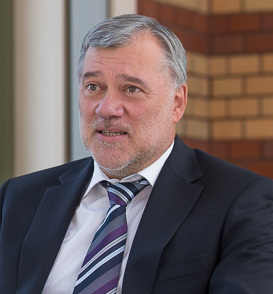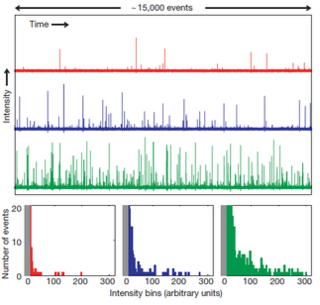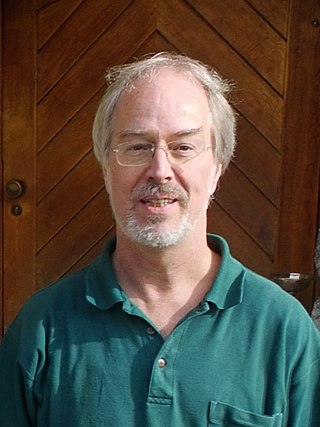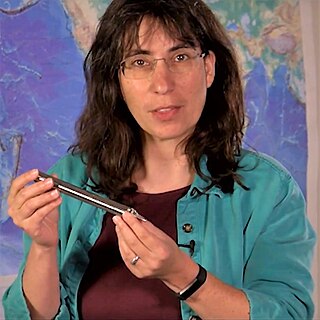
An optical microcavity or microresonator is a structure formed by reflecting faces on the two sides of a spacer layer or optical medium, or by wrapping a waveguide in a circular fashion to form a ring. The former type is a standing wave cavity, and the latter is a traveling wave cavity. The name microcavity stems from the fact that it is often only a few micrometers thick, the spacer layer sometimes even in the nanometer range. As with common lasers, this forms an optical cavity or optical resonator, allowing a standing wave to form inside the spacer layer or a traveling wave that goes around in the ring.
Harry L. Swinney is an American physicist noted for his contributions to the field of nonlinear dynamics.
Objective-collapse theories, also known as models of spontaneous wave function collapse or dynamical reduction models, are proposed solutions to the measurement problem in quantum mechanics. As with other theories called interpretations of quantum mechanics, they are possible explanations of why and how quantum measurements always give definite outcomes, not a superposition of them as predicted by the Schrödinger equation, and more generally how the classical world emerges from quantum theory. The fundamental idea is that the unitary evolution of the wave function describing the state of a quantum system is approximate. It works well for microscopic systems, but progressively loses its validity when the mass / complexity of the system increases.
A macroscopic quantum state is a state of matter in which macroscopic properties, such as mechanical motion, thermal conductivity, electrical conductivity and viscosity, can be described only by quantum mechanics rather than merely classical mechanics. This occurs primarily at low temperatures where little thermal motion is present to mask the quantum nature of a substance.

Tilman Esslinger is a German experimental physicist. He is Professor at ETH Zurich, Switzerland, and works in the field of ultracold quantum gases and optical lattices.

Jürgen Kurths is a German physicist and mathematician. He is senior advisor in the research department Complexity Sciences of the Potsdam Institute for Climate Impact Research, a Professor of Nonlinear Dynamics at the Institute of Physics at the Humboldt University, Berlin, and a 6th-century chair for Complex Systems Biology at the Institute for Complex Systems and Mathematical Biology at Kings College, Aberdeen University (UK). His research is mainly concerned with nonlinear physics and complex systems sciences and their applications to challenging problems in Earth system, physiology, systems biology and engineering.
David J. Pine is an American physicist who has made contributions in the field of soft matter physics, including studies on colloids, polymers, surfactant systems, and granular materials. He is professor of physics in the NYU College of Arts and Science and chair of the Department of Chemical and Biomolecular Engineering at the NYU Tandon School of Engineering.

Optical rogue waves are rare pulses of light analogous to rogue or freak ocean waves. The term optical rogue waves was coined to describe rare pulses of broadband light arising during the process of supercontinuum generation—a noise-sensitive nonlinear process in which extremely broadband radiation is generated from a narrowband input waveform—in nonlinear optical fiber. In this context, optical rogue waves are characterized by an anomalous surplus in energy at particular wavelengths or an unexpected peak power. These anomalous events have been shown to follow heavy-tailed statistics, also known as L-shaped statistics, fat-tailed statistics, or extreme-value statistics. These probability distributions are characterized by long tails: large outliers occur rarely, yet much more frequently than expected from Gaussian statistics and intuition. Such distributions also describe the probabilities of freak ocean waves and various phenomena in both the man-made and natural worlds. Despite their infrequency, rare events wield significant influence in many systems. Aside from the statistical similarities, light waves traveling in optical fibers are known to obey the similar mathematics as water waves traveling in the open ocean, supporting the analogy between oceanic rogue waves and their optical counterparts. More generally, research has exposed a number of different analogies between extreme events in optics and hydrodynamic systems. A key practical difference is that most optical experiments can be done with a table-top apparatus, offer a high degree of experimental control, and allow data to be acquired extremely rapidly. Consequently, optical rogue waves are attractive for experimental and theoretical research and have become a highly studied phenomenon. The particulars of the analogy between extreme waves in optics and hydrodynamics may vary depending on the context, but the existence of rare events and extreme statistics in wave-related phenomena are common ground.

Gerhard Rempe is a German physicist, Director at the Max Planck Institute of Quantum Optics and Honorary Professor at the Technical University of Munich. He has performed pioneering experiments in atomic and molecular physics, quantum optics and quantum information processing.
Chandrashekhar "Chan" Janardan Joshi is an Indian–American experimental plasma physicist. He is known for his pioneering work in plasma-based particle acceleration techniques for which he won the 2006 James Clerk Maxwell Prize for Plasma Physics and the 2023 Hannes Alfvén Prize.

Baruch Barzel is an Israeli physicist and applied mathematician at Bar-Ilan University, a member of the Gonda Multidisciplinary Brain Research Center and of the Bar-Ilan Data Science Institute. His main research areas are statistical physics, complex systems, nonlinear dynamics and network science.

Michel Devoret is a French physicist and F. W. Beinecke Professor of Applied Physics at Yale University. He also holds a position as the Director of the Applied Physics Nanofabrication Lab at Yale. He is known for his pioneering work on macroscopic quantum tunneling, and the single-electron pump as well as in groundbreaking contributions to initiating the fields of circuit quantum electrodynamics and quantronics.
Bose–Einstein condensation of polaritons is a growing field in semiconductor optics research, which exhibits spontaneous coherence similar to a laser, but through a different mechanism. A continuous transition from polariton condensation to lasing can be made similar to that of the crossover from a Bose–Einstein condensate to a BCS state in the context of Fermi gases. Polariton condensation is sometimes called “lasing without inversion”.

Marine ice sheet instability (MISI) describes the potential for ice sheets grounded below sea level to destabilize in a runaway fashion. The mechanism was first proposed in the 1970s by Johannes Weertman and was quickly identified as a means by which even gradual anthropogenic warming could lead to relatively rapid sea level rise. In Antarctica, the West Antarctic Ice Sheet, the Aurora Subglacial Basin, and the Wilkes Basin are each grounded below sea level and are inherently subject to MISI.

Emily E. Brodsky is a Professor of Earth Sciences at the University of California, Santa Cruz. She studies the fundamental physical properties of earthquakes, as well as the seismology of volcanoes and landslides. In 2023, she was elected to the National Academy of Sciences.
Eran Rabani is an Israeli theoretical chemist. He is a professor of chemistry at the University of California, Berkeley, holding the Glenn T. Seaborg Chair in Physical Chemistry, and at the Tel Aviv University. Rabani serves as the director of The Sackler Center for Computational Molecular and Materials Science, and as a faculty scientist at the Lawrence Berkeley National Laboratory.

Max Born was a widely influential German physicist and mathematician who was awarded the 1954 Nobel Prize in Physics for his pivotal role in the development of quantum mechanics. Born won the prize primarily for his contributions to the statistical interpretation of the wave function, though he is known for his work in several areas of quantum mechanics as well as solid-state physics, optics, and special relativity. Born's entry in the Biographical Memoirs of Fellows of the Royal Society included thirty books and 330 papers.

Jean-François Molinari is a French-Swiss engineer and scientist specialised in the numerical modeling of the mechanics of materials and structures. He is a full professor and the director of the Computational Solid Mechanics Laboratory at the École Polytechnique Fédérale de Lausanne (EPFL).

John Martin Kolinski is an American engineer. He is a professor at EPFL and the head of the Laboratory of Engineering Mechanics of Soft Interfaces (EMSI) at EPFL's School of Engineering.
Seth J. Putterman is an American physicist. He is known to have an eclectic approach to research topics that broadly revolves around energy-focusing phenomena in nonlinear, continuous systems, with particular interest in turbulence, sonoluminescence, sonofusion and pyrofusion.












